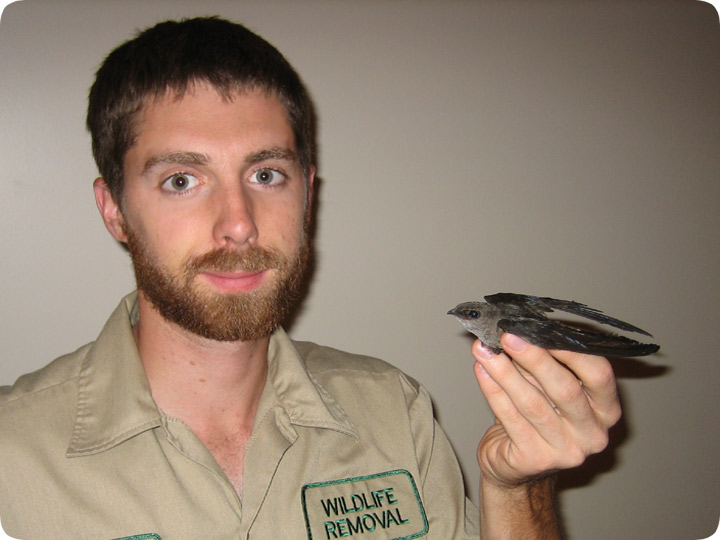-
info@aaanimalcontrol.com
Call us for help in your town
Humane Wildlife Education
Chimney Swift Removal

The Chimney Swift is one of North America's more remarkable birds. They are fantastic fliers: they catch their food, insects, on the wing, and even snatch up nesting twigs on the wing. They use these twigs to build a nest, which they adhere to the wall of a cavern using special sticky saliva. While in nature they may prefer hollowed out trees (what animal doesn't love a hollowed-out tree? This seems to be the default habitat for any animal. I mean, how many hollowed out trees are there, anyway?), they really seem to thrive in chimneys. Using their superb flying skills, they can fly in and out of the vertical flu, a feat not many birds could match. They cling to the wall of the flu - even the smooth metal surfaces of the steel pipe flus so common in Florida. They have sticky sharp claws.
In spring, they (I don't know if it's just the female or what) build a nest, and affix it to the wall of the chimney flu. So far, no big deal. I'm sure most homeowners don't even notice. But then the young swifts hatch. The homeowners most definitely notice. The animal kingdom is full of loud animals - elephants, howler monkeys, congressmen, but none compare to a nest of hatching Chimney Swifts. They make a ridiculous racket. The thing is, once one bird starts, they all start. In a nest of four, it's a din and a half. Add in the acoustics of a chimney - often a metal one - and the sound is enough to deafen a man. Thus, people call me about the racket, and out I come. If I find a nest of Chimney Swifts, I try to leave it alone. "Why not wait a week or two?" I say, hoping that I don't have to disturb the nest. Some people relax when they hear that it's just harmless and delightful Chimney Swifts. But some people say, "if you don't remove it, I will!". In this case, I remove the young, shoo out the mom if she's there, cap the chimney, and bring the hatchlings to a wonderful bird rehabber here in Orlando - Anne Young. She takes good care of these spectacular birds.
Do it yourself: Visit my How To Get Rid of Birds page for tips and advice.
Get professional help: Visit my Nationwide Pro Directory of wildlife removal experts.
For more wildlife stories, click my Wildlife Blog or click my below banner to hire a local trapper.

Migratory birds are a beauty to behold when they fly in the sky, but when you have them in your home it's a whole new experience. Having them in your home, most especially your chimney, can freak you out and make you want to do anything just to get them out. Due to its hollow structure, this part of every home is usually the favorite nesting place for birds, and having them there can cause so much distress.
Do you have a chimney swift bird in your chimney and are looking for a way to remove it? This small cigar-shaped migrating bird can take away the peace you have with just its short stay in your home. Right here, we will be sharing all you need to know about how to remove chimney swift birds from your home.
But before we go any further, you need to understand the fact that chimney swifts are a protected species by law. This simply means that hurting or killing them is highly prohibited and you will have to look for a humane removal process.
What are Chimney Swifts?
These are brownish-grey birds with a relatively small size. The natural habitat of a chimney swift is hollow trees. But due to the increasing expansions of suburban and urban areas, these birds are beginning to nest in different homes. Unlike other birds, chimney swifts build their nest vertically because their body structure doesn't support upright stands and perches.
Due to the Federal Migratory Bird Treaty Act which prohibits people from destroying the eggs, young, or actual adult chimney swifts, you will have to first wait for a couple of weeks to allow the eggs of the bird to hatch and mature before you can be able to safely remove them.
How to Remove Chimney Swifts
When it comes to removing chimney swifts from a chimney, the best way to do this humanely is to either wait until the birds and their young are out of the chimney and then seal off the chimney with a proper fitting chimney cap (Note: chimney swifts are known to come back to their nesting point after migrating, so it is important you seal off properly) or hire a professional wildlife remover to help you out.
Perhaps you choose to do this by yourself, the first thing you need to do is to know the stage of development of the birds inside your chimney. To do this, you have to be very observant. If you have chimney swifts flying around your home and you barely hear any disrupting sound in your chimney, there is a high probability that the bird has newly- lain eggs inside the chimney. If that is the case, you will have to wait for some weeks because the eggs take about 6 weeks before they hatch.
If you keep hearing crippling sounds in your chimney, chances are that the eggs just hatched into hatchlings and they take 4 weeks before they are mature enough to take their first flight. Having realized this, you need to put all these timings into consideration to make sure your chimney is empty before going ahead to seal it.
Smoking them is another way to get rid of them, but this is not a humane removal method, as the smoke might kill them before they get a chance to fly out.




















